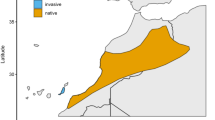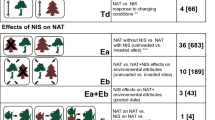Abstract
The novel interactions posed by invasive species can have complex effects on ecosystems owing to both their direct and indirect effects on other species. Consequently, the effects of invasive species can be hard to forecast owing to the diversity of interaction-pathways and number of species they can potentially affect. Ultimately, the strength and direction of an invader’s inter-specific effects will be determined by both the traits of the invader and the species they interact with. The cane toad (Rhinella marina) is a highly successful invasive species that poses a serious threat to ecosystem integrity in tropical Australia. Reptilian predators have been particularly affected by the invasion of cane toads because toads possess toxins that are novel to native Australian predators. We used a meta-regression approach to explore how cane toads’ impacts on Australian squamates are modulated by their phylogenetic, behavioural and morphological traits. Species primarily foraging in riparian and terrestrial habitats tended to decline in abundance while population sizes of arboreal squamates might have increased following toad arrival. The negative impact of cane toads on anurophagous squamates scaled with gape size and body mass. Squamate species with smaller heads or body mass tended to increase in abundance while species with larger heads or body mass tended to decline. Our study provides insight into the complexity of impacts that invasive species can have on native species assemblages and highlights how morphological and behavioural factors can mediate the impact of invasive on native species.




Similar content being viewed by others
References
Brown G, Phillips BL, Shine R (2011) The ecological impact of invasive cane toads on tropical snakes: field data do not support laboratory-based predictions. Ecology 92:422–431
Brown G, Greenlees M, Phillips BL, Shine R (2013a) Road transect surveys do not reveal any consistent effects of a toxic invasive species on tropical reptiles. Biol Invasions 15:1005–1015
Brown G, Ujvari B, Madsen T, Shine R (2013b) Invader impact clarifies the roles of top-down and bottom-up effects on tropical snake populations. Funct Ecol 27:351–361
Bruno JF, Stachowicz JJ, Bertness MD (2003) Inclusion of facilitation into ecological theory. TREE 18:119–125
Daly J, Myers C, Whittaker N (1987) Further classification of skin alkaloids from neotropical poison frogs (Dendrobatidae), with a general survey of toxic/noxious substances in the amphibia. Toxicon 25:1023–1095
Doody S, Green B, Sims R, Rhind D, West P, Steer D (2006) Indirect impacts of invasive cane toads (Bufo marinus) on nest predation in pig-nosed turtles (Carettochelys insculpta). Wildl Res 33:349–354
Doody S, Green B, Rhind D, Castellano C, Sims R, Robinson T (2009) Population-level declines in Australian predators caused by an invasive species. Anim Conserv 12:46–53
Doody S, Castellano C, Rhind D, Green B (2013) Indirect facilitation of a native mesopredator by an invasive species: are cane toads re-shaping tropical riparian communities? Biol Invasions 15:559–568
Doody S, Mayes P, Clulow S, Rhind D (2014) Impacts of the invasive cane toad on aquatic reptiles in a highly modified ecosystem: the importance of replicating impact studies. Biol Invasions. doi:10.1007/s10530-014-0665-6
Fisher DO, Owens IPF (2004) The comparative method in conservation biology. TREE 19:391–398
Greenlees MJ, Brown GP, Webb JK, Phillips BL, Shine R (2007) Do invasive cane toads (Chaunus marinus) compete with Australian frogs (Cyclorana australis)? Austral Ecol 32:900–907
Griffiths A, McKay J (2007) Cane toads reduce the abundance and site occupancy of Merten’s water monitor (Varanus mertensi). Wildl Res 34:609–615
Hayes RA, Crossland MR, Hagman M, Capon RJ, Shine R (2009) Ontogenetic variation in the chemical defenses of cane toads (Bufo marinus): toxin profiles and effects on predators. J Chem Ecol 35:391–399
Herrel A, Aerts P, De Vree F (1997) Ecomorphology of the lizard feeding apparatus: a modelling approach. Neth J Zool 48:1–25
Johnson CN, Isaac JL (2009) Body mass and extinction risk in Australian marsupials: the “Critical Weight Range” revisited. Austral Ecol 34:35–40
Kuch U, Keogh J, Weigel J, Smith L, Mebs D (2005) Phylogeography of Australia’s king brown snake (Pseudechis australis) reveals Pliocene divergence and Pleistocene dispersal of a top predator. Naturwissenschaften 92:121–127
Letnic M, Webb JK, Shine R (2008) Invasive cane toads (Bufo marinus) cause mass mortality of freshwater crocodiles (Crocodylus johnstoni) in tropical Australia. Biol Conserv 141:1773–1782
Letnic M, Koch F, Gordon C, Crowther MS, Dickman CR (2009) Keystone effects of an alien top-predator stem extinctions of native mammals. Proc R Soc B 276:3249–3256
Lever C (2001) The cane toad: the history and ecology of a successful colonist. Westbury Academic and Scientific Publishing, Otley, West Yorkshire
Llewelyn JS, Phillips BL, Shine R (2009) Sublethal costs associated with the consumption of toxic prey by snakes. Austral Ecol 34:179–184
Mack RN, Simberloff D, Lonsdale W, Evans H, Clout M, Bazzaz FA (2000) Biotic invasions: causes, epidemiology, global consequences, and control. Ecol Appl 10:689–710
Møller A, Jennions M (2001) Testing and adjusting for publication bias. TREE 16:580–586
Montoya JM, Pimm SL, Solé RV (2006) Ecological networks and their fragility. Nature 442:259–264
Nakagawa S, Ockendon N, Gillespie DOS, Hatchwell BJ, Burke T (2007) Assessing the function of house sparrows’ bib size using a flexible meta-analysis method. Behav Ecol 18:831–840
Parker I, Simberloff D, Lonsdale W, Goodell K, Wonham M, Kareiva P, Williamson M, Von Holle B, Moyle P, Byers J et al (1999) Impact: toward a framework for understanding the ecological effects of invaders. Biol Invasions 1:3–19
Pearson D, Shine R, Williams A (2002) Geographic variation in sexual size dimorphism within a single snake species (Morelia spilota, Pythonidae). Oecologia 131:418–426
Phillips BL, Shine R (2004) Adapting to an invasive species: toxic cane toads induce morphological change in Australian snakes. PNAS 101:17150–17155
Phillips BL, Shine R (2006a) Allometry and selection in a novel predator–prey system: Australian snakes and the invading cane toad. Oikos 1:122–130
Phillips BL, Shine R (2006b) The morphology, and hence impact, of an invasive species (the cane toad, Bufo marinus): changes with time since colonisation. Anim Conserv 8:407–413
Phillips BL, Brown G, Shine R (2003) Assessing the potential impact of cane toads on Australian snakes. Conserv Biol 17:1738–1747
Phillips BL, Greenlees MJ, Brown GP, Shine R (2010) Predator behaviour and morphology mediates the impact of an invasive species: cane toads and death adders in Australia. Anim Conserv 13:53–59
Price-Rees SJ, Brown GP, Shine R (2010) Predation on toxic cane toads (Bufo marinus) may imperil bluetongue lizards (Tiliqua scincoides intermedia, Scincidae) in tropical Australia. Wildl Res 37:166–173
Rodriguez LF (2006) Can invasive species facilitate native species? Evidence of how, when, and why these impacts occur. Biol Invasions 8:927–939
Rosenthal R (1979) The file drawer problem and tolerance for null results. Psychol Bull 83:638–641
Shine R (2010) The ecological impact of invasive cane toads (Bufo marinus) in Australia. Q Rev Biol 85:253–291
Skinner A (2009) A multivariate morphometric analysis and systematic review of Pseudonaja (Serpentes, Elapidae, Hydrophiinae). Zool J Linn Soc 155:171–197
Smith J, Phillips BL (2006) Toxic tucker: the potential impact of cane toads on Australian reptiles. Pac Conserv Biol 12:40–49
Somaweera R, Shine R, Webb J, Dempster T, Letnic M (2013) Why does vulnerability to toxic invasive cane toads vary among populations of Australian freshwater crocodiles? Anim Conserv 16:86–96
Strayer DL, Eviner VT, Jeschke JM, Pace ML (2006) Understanding the long-term effects of species invasions. TREE 21:645–651
Thomson D (1933) Notes on Australian snakes of the genera Pseudechis and Oxyuranus. Proc Zool Soc Lond 103:855–860
Ujvari B, Shine R, Madsen T (2011) Detecting the impact of invasive species on native fauna: cane toads (Bufo marinus), frillneck lizards (Chlamydosaurus kingii) and the importance of spatial replication. Austral Ecol 36:126–130
Ujvari B, Mun H, Conigrave AD, Bray A, Osterkamp J, Halling P, Madsen T (2012) Isolation breeds naivety: island living robs Australian varanid lizards of toad-toxin immunity via four-base-pair mutation. Evolution 67:289–294
Urban MC, Phillips BL, Skellu DS, Shine R (2007) The cane toad’s (Chaunus marinus) increasing ability to invade Australia is revealed by a dynamically updated range model. Proc R Soc B 274:1413–1419
Vitousek P, D’Antonio C (1997) Introduced species: a significant component of human-caused global change. N Z J Ecol 21:1–16
Zug G, Zug P (1979) The marine toad, Bufo marinus: a natural history resume of native populations. Smithsonian Institution Press, Washington, DC
Acknowledgments
We thank Christopher Turbill, Andrew Letten, Anna Feit and three anonymous reviewers for helpful comments on earlier drafts of the manuscript. Funding for this study was provided by the Hermon Slade Foundation and the Mazda Foundation.
Author information
Authors and Affiliations
Corresponding author
Additional information
Communicated by Karen E. Hodges.
Rights and permissions
About this article
Cite this article
Feit, B., Letnic, M. Species level traits determine positive and negative population impacts of invasive cane toads on native squamates. Biodivers Conserv 24, 1017–1029 (2015). https://doi.org/10.1007/s10531-014-0850-z
Received:
Revised:
Accepted:
Published:
Issue Date:
DOI: https://doi.org/10.1007/s10531-014-0850-z




